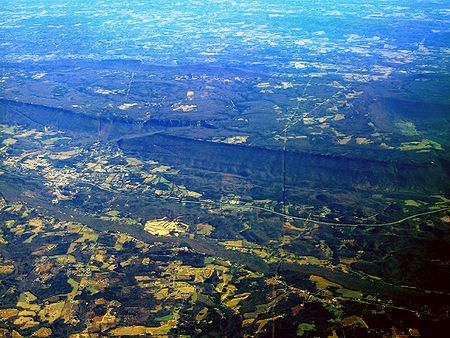- Cuesta
-
In structural geology and geomorphology, a cuesta (from Spanish: "slope") is a ridge formed by gently tilted sedimentary rock strata in a homoclinal structure.[1][2] Cuestas have a steep slope, where the rock layers are exposed on their edges, called an escarpment or, if more steep, a cliff. Usually an erosion-resistant rock layer also has a more gentle slope on the other side of the ridge called a dip slope. Because the slope of a homoclinal ridge dips in the same direction as the sedimentary strata, the dip angle of this bedding (Ө) can be calculated by v/h= tan(Ө) where v is equal to the vertical distance and h is equal to the horizontal distance perpendicular to the strike of the beds.[3]
Contents
Examples of cuestas
Two well-known cuestas in western New York and southern Ontario are the Onondaga escarpment and the Niagara escarpment, respectively. The dip of the Onondaga is about 40 feet per mile (about 7.6 m/km) to the south. The escarpment edge faces north and, in its most populated section, runs roughly parallel to the southern Lake Ontario shoreline.
The Gulf Coastal Plain in Texas is punctuated by a series of cuestas that parallel the coast, as are most coastal plains.[4] The Reynosa Plateau is the most coast-ward cuesta, which sees surface expression with the Bordes-Oakville escarpment, on the northwest side and a low ridge on the eastern boundary, called the Reynosa cuesta, where the deposits dip below later Pliocene-Pleistocene deposits of the Willis and Lissie Formation.
Cuestas have less dramatic expression in the United Kingdom, with two notable examples being the northwest-facing escarpment of the Jurassic chalk White Horse Hills and the similarly-aligned escarpment of the Cotswolds, sometimes called the Cotswold Edge.
In continental Europe, the Swabian Alb offers particularly good views of cuestas in Jurassic rock. In France, the term for a cuesta is the same as for a coastline: "côte". Notable French cuestas are the wine-growing regions of Côte d'Or and Côtes du Rhône.
References
- ^ Monkhouse, F. J. A Dictionary of Geography. London: Edward Arnold, 1978
- ^ "Cuesta, or homoclinal ridge (geology)". Britannica Online Encyclopedia. http://www.britannica.com/eb/topic-145944/cuesta. Retrieved 2008-03-16. "Cuestas with dip slopes of 40°–45° or higher are usually called hogback ridges."
- ^ Don J. Easterbrook. Surface Processes and Landforms. Upper Saddle River, New Jersey: Prentice-Hall, inc, 1999, Second Edition, p. 228.
- ^ Strahler, Arthur N. Physical Geography. New York: John Wiley & Sons, Inc, 1960 (second edition), p. 451
See also
External links
Categories:- Geomorphology
- Structural geology
- Slope landforms
- Erosion landforms
Wikimedia Foundation. 2010.



